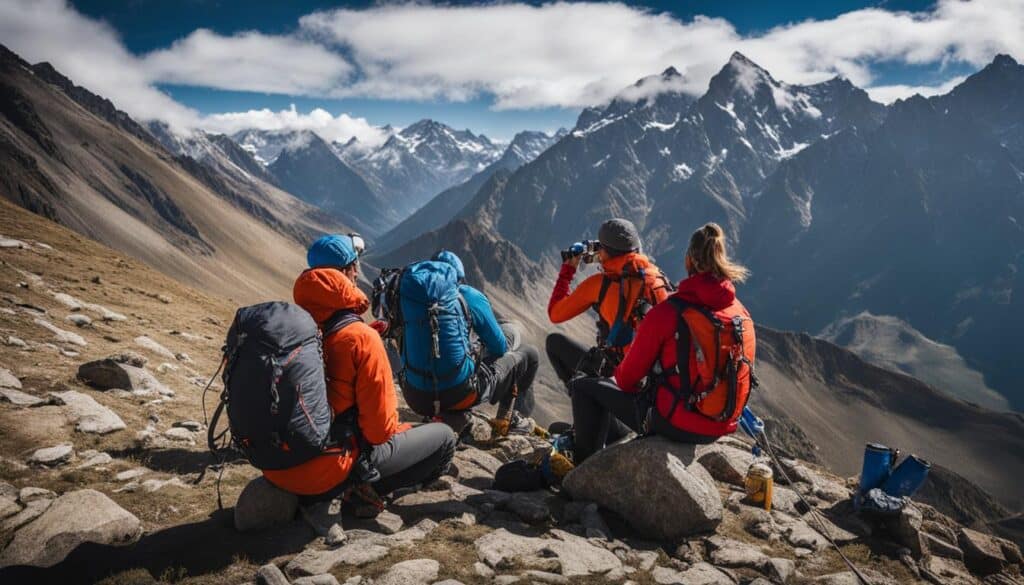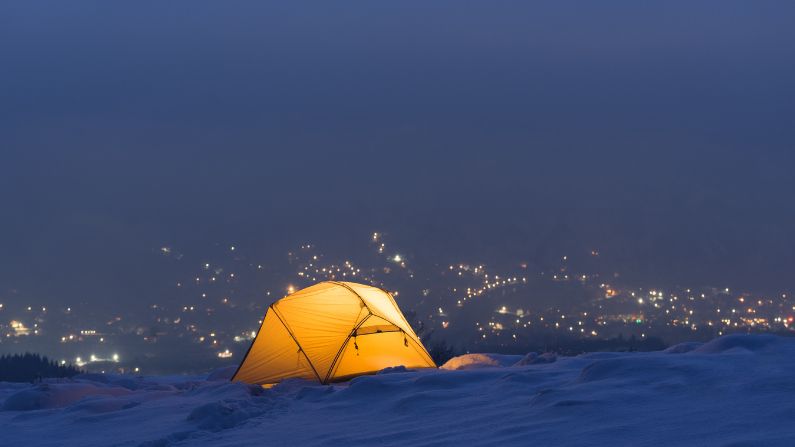High altitude camping, also known as camping at high altitudes, offers a unique and thrilling experience for outdoor enthusiasts. The thin air, cold temperatures, and breathtaking views make it a truly unforgettable adventure.
Imagine waking up to the crisp mountain air, surrounded by majestic peaks and untouched wilderness. The sense of peace and tranquility is unmatched. But high altitude camping isn’t just about the beauty of nature; it’s about overcoming challenges and pushing your limits.
During high altitude camping, you’ll face reduced oxygen levels, extreme bad weather conditions, and physical exertion. It requires proper preparation and acclimatization to ensure your safety and enjoyment.
In this article, I will guide you through the essential tips for preparing and acclimating to the altitude, tackling the challenges, enjoying the rewards, and ensuring your safety during high altitude camping. Let’s embark on this thrilling adventure together!
Preparing for the Altitude: Essential Tips for Extreme Altitude Camping
When embarking on a high altitude camping adventure, proper preparation is key to ensure a safe and enjoyable experience. Here are some essential tips to keep in mind:
- Acclimatization: One of the most important aspects of high altitude camping is acclimatizing to the elevation. Gradually ascending to higher altitudes allows your body to adjust to the thinner air and reduces the risk of altitude sickness. Plan your itinerary accordingly, allowing time for your body to adapt.
- Hydration: Staying hydrated is crucial when camping at high altitudes. The dry air and increased physical activity can lead to dehydration. Drink plenty of water throughout the day and consider carrying a water bottle with a built-in filter to ensure a constant supply of clean water.
- Packing Essentials: Make sure to pack appropriate clothing and gear for the extreme conditions you may encounter. Layering is essential to regulate body temperature, so bring thermal base layers, insulating mid-layers, and a waterproof outer layer. Don’t forget to pack a high altitude sleeping bag and a sturdy tent designed to withstand strong winds.
- Sun Protection: The higher you go, the closer you are to the sun, making sun protection crucial. Apply a high SPF sunscreen to all exposed skin and wear a wide-brimmed hat and UV-rated sunglasses. Additionally, consider using lip balm with SPF to protect your lips from the harsh mountain sun.
By following these essential tips, you’ll be well-prepared for the challenges of high altitude camping and can fully enjoy the breathtaking beauty of the mountains.
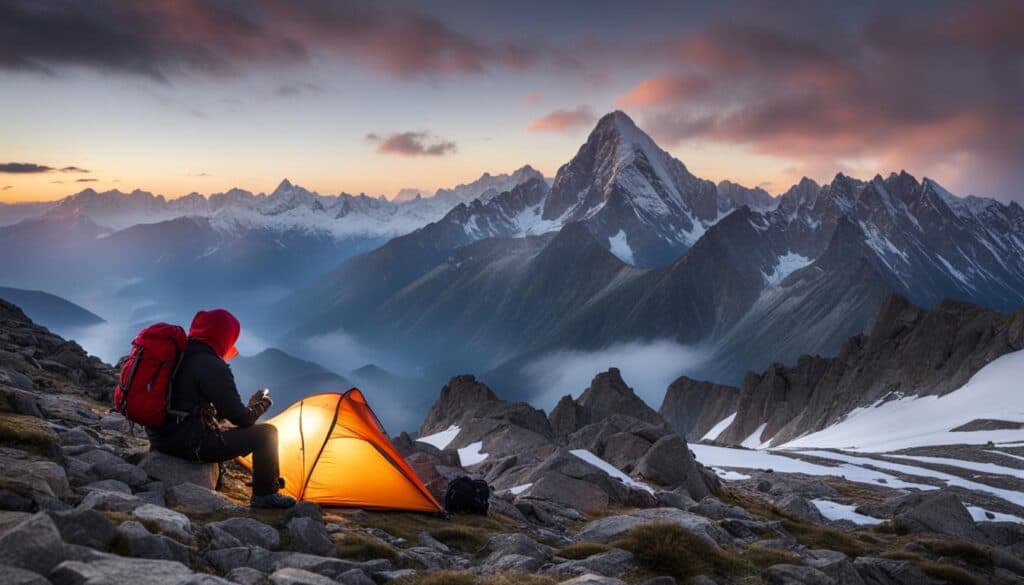
Table: Essential Gear for High Altitude Camping
| Item | Description |
|---|---|
| High Altitude Sleeping Bag | A sleeping bag designed for cold temperatures and high altitudes. Look for one with a temperature rating suitable for the expected weather conditions. |
| Layered Clothing | A set of thermal base layers, insulating mid-layers, and a waterproof outer layer for effective temperature regulation in changing conditions. |
| Sturdy Tent | A tent designed to withstand strong winds and potential snowfall. Look for a freestanding tent with a durable frame and waterproof materials. |
| Water Filtration System | A portable water filter or purification tablets to ensure a safe and reliable water source while camping in remote high altitude locations. |
| High SPF Sunscreen | A sunscreen with a high sun protection factor (SPF) to shield your skin from the intense mountain sun. |
| Wide-Brimmed Hat | A hat with a wide brim to protect your face, neck, and ears from sunburn and glare. |
| UV-Rated Sunglasses | Sunglasses with UV protection to shield your eyes from harmful sun rays and glare. |
| Lip Balm with SPF | A lip balm with sun protection to prevent chapped lips and sunburn. |
Having the right gear will enhance your comfort and safety during high altitude camping, allowing you to fully enjoy the wonders of the mountains.
Tackling the Challenges: Overcoming Obstacles in Extreme Altitude Camping
Camping at high altitudes presents its fair share of challenges. From reduced oxygen levels to extreme weather conditions and physical exertion, outdoor enthusiasts must be prepared to tackle these obstacles for a successful camping experience in the mountains.
1. Altitude Sickness Prevention
One of the primary challenges of high altitude camping is the risk of altitude sickness. This condition can range from mild symptoms such as headaches and nausea to more severe cases that require immediate medical attention. To prevent altitude sickness, it is essential to acclimate properly by gradually ascending to higher altitudes and allowing your body time to adjust. Staying well-hydrated, avoiding alcohol and caffeine, and taking over-the-counter medications like acetazolamide can also help alleviate symptoms.
2. Dealing with Extreme Weather Conditions
Mountains are known for their unpredictable weather, and high altitude camping is no exception. Be prepared for sudden temperature drops below 30 dgrees, strong winds, and even snowfall. Pack appropriate clothing layers to stay warm, including insulated jackets, thermal base layers, and waterproof outerwear. It is also crucial to bring a high-quality tent that can withstand strong winds and provide adequate protection from the elements.
3. Physical Exertion and Fatigue
Camping at high altitudes requires greater physical exertion due to the thin air and increased difficulty in breathing. It’s important to pace yourself and take frequent breaks to avoid overexertion. Engaging in regular physical exercise prior to your camping trip can also help improve your overall fitness level. Additionally, carrying a lightweight backpack and using trekking poles can make hiking and navigating challenging terrains more manageable.
By acknowledging and preparing for these challenges, outdoor enthusiasts can overcome the obstacles associated with high altitude camping and fully enjoy the breathtaking beauty that mountain camping has to offer.
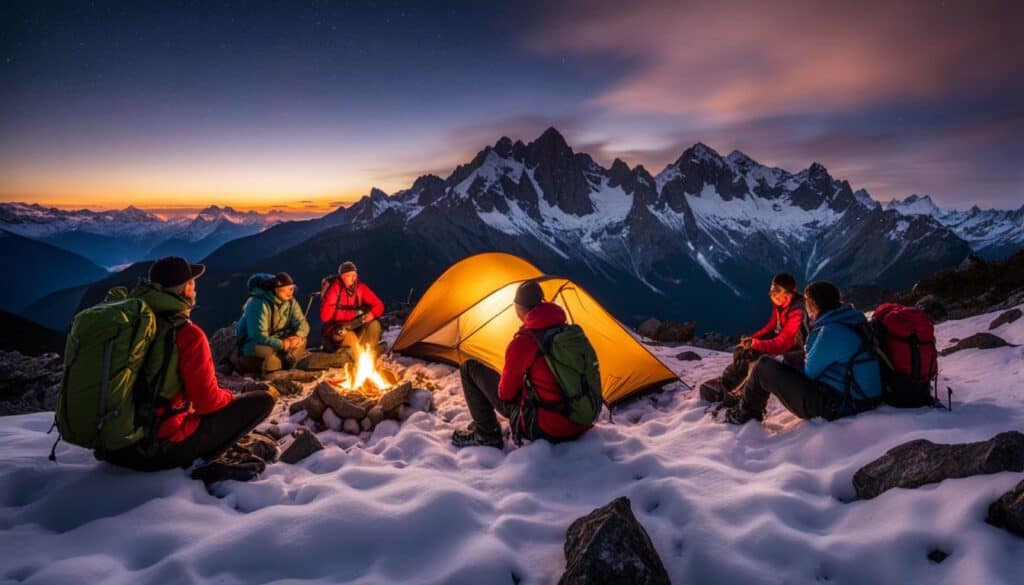
| Challenge | Prevention/Preparation |
|---|---|
| Altitude Sickness | – Gradual ascent and proper acclimatization – Staying hydrated and avoiding alcohol/caffeine – Using over-the-counter medications like acetazolamide |
| Extreme Weather Conditions | – Layered clothing for warmth – Waterproof and wind-resistant gear – High-quality tent for protection |
| Physical Exertion | – Pacing yourself and taking frequent breaks – Regular exercise prior to the camping trip – Using lightweight backpacks and trekking poles |
After Reading This Article Read This: Camping In A Thunderstorm
Experiencing the Rewards: Enjoying the Benefits of High Altitude Camping
High altitude camping offers a thrilling and unforgettable experience that allows you to immerse yourself in the breathtaking beauty of the mountains. From the awe-inspiring vistas to the sense of solitude and tranquility, camping in the mountains provides a unique opportunity to reconnect with nature and escape the hustle and bustle of everyday life. Whether you’re camping above the treeline or nestled in a valley, the rewards of high altitude camping are plentiful.
One of the major benefits of camping in the mountains is the opportunity to witness stunning sunrises and sunsets. As you wake up to the first light of dawn or watch the sun dip below the horizon, you’ll be treated to a spectacular display of colors that will leave you in awe. The clear, unpolluted skies at high altitudes also provide incredible stargazing opportunities, allowing you to marvel at the vastness of the universe.
Camping in the mountains also offers a chance to challenge yourself physically and mentally. The rugged terrain, steep ascents, and demanding hikes test your endurance and push you to reach new heights. As you conquer each obstacle and overcome the physical challenges, you’ll experience a sense of accomplishment and fulfillment like no other. Plus, the fresh mountain air and invigorating atmosphere can have a rejuvenating effect on your mind and body, leaving you feeling refreshed and revitalized.
Furthermore, high altitude camping allows you to disconnect from the distractions of modern technology and connect with the natural world. Without the constant buzz of notifications and the temptation to scroll through social media, you can fully embrace the simplicity of nature. Whether it’s listening to the sound of a rushing stream, spotting wildlife in their natural habitat, or simply sitting by a campfire under a starry sky, high altitude camping offers a chance to appreciate the beauty and serenity of the great outdoors.
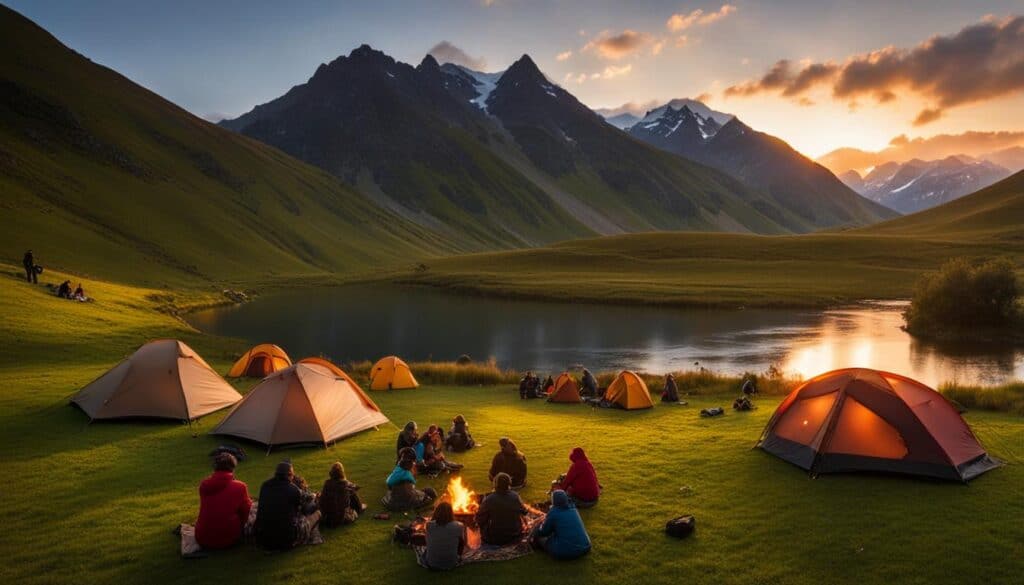
Table: Top Benefits of High Altitude Camping
| Benefits | Description |
|---|---|
| Stunning Scenery | Experience breathtaking views, majestic mountains, and picturesque landscapes. |
| Spectacular Sunrises and Sunsets | Witness vibrant colors painting the sky as the sun rises and sets over the mountains. |
| Challenging Adventure | Push yourself physically and mentally with rugged terrain and demanding hikes. |
| Rejuvenating Atmosphere | Breathe fresh mountain air and enjoy the tranquility and serenity of the natural environment. |
| Nature Connection | Disconnect from technology and immerse yourself in the simplicity and beauty of nature. |
Choosing the Right Campsite
When embarking on a high altitude camping adventure, selecting the right campsite is crucial for a successful and enjoyable experience. Consider the following factors to ensure a safe and comfortable stay in the mountains.
Altitude and Accessibility
First and foremost, consider the altitude of the campsite. Opt for a location that is suitable for your level of experience with high altitude camping. If you are a beginner, choose a campsite that is at a lower elevation to help your body adjust to the thin air. Additionally, assess the accessibility of the site. Look for a campsite that is easily reachable, minimizing the physical exertion required to set up camp.
Weather and Shelter
Take into account the weather conditions at the campsite. Research the average temperatures, wind patterns, and precipitation to better prepare for the elements. Look for a campsite that provides natural windbreaks, such as trees or rock formations, to shield your tent from strong gusts. Additionally, consider the availability of water sources and the proximity to emergency services, just in case unexpected weather changes occur.
Environmental Considerations
When choosing a campsite, respect and prioritize the preservation of the environment. Look for designated camping areas to minimize your impact on the fragile ecosystem. Avoid setting up camp near water sources or wildlife habitats to maintain the natural balance. Follow Leave No Trace principles by practicing proper waste disposal and respecting the surroundings.
| Factors to Consider | Important Points |
|---|---|
| Altitude and Accessibility | – Choose a suitable altitude for your experience level – Consider ease of access to the campsite |
| Weather and Shelter | – Research average temperatures, wind patterns, and precipitation – Look for natural windbreaks and consider proximity to water sources and emergency services |
| Environmental Considerations | – Respect designated camping areas to minimize impact – Avoid setting up camp near water sources or wildlife habitats |
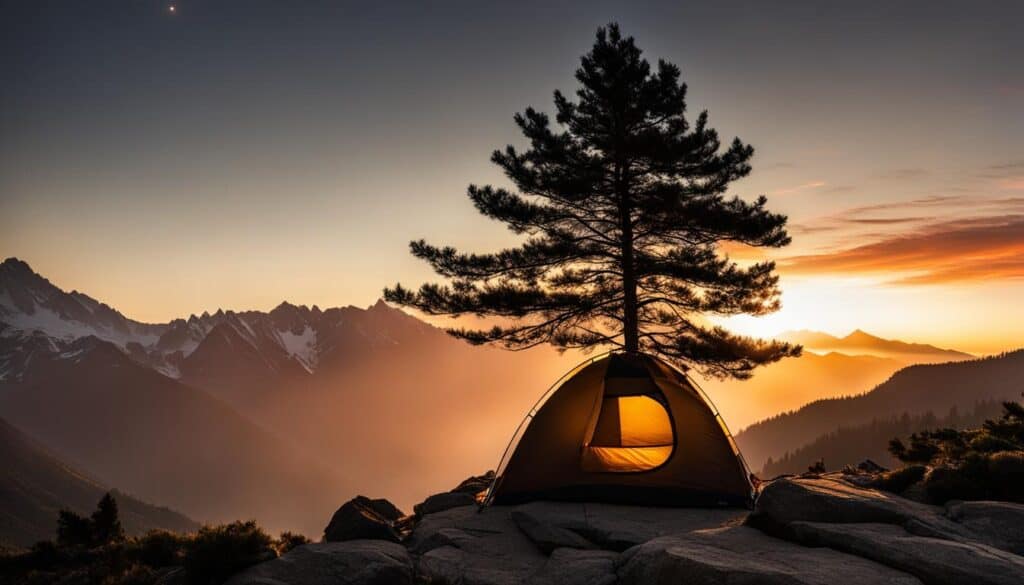
By carefully considering these factors, you can choose a campsite that suits your needs and enhances your high altitude camping experience. Remember to prioritize safety, comfort, and environmental stewardship as you embark on your mountain adventure.
Reinforcing Your Shelter
When camping at high altitudes, it’s essential to reinforce your shelter to protect yourself from strong winds and unpredictable weather conditions. Here are some tips to ensure your shelter is sturdy and secure:
Choose a High Altitude Tent
Investing in a high altitude tent specifically designed for extreme conditions is crucial. Look for tents that are made of durable materials, have sturdy poles, and are built to withstand strong winds. These tents are often designed with reinforced seams and extra guy lines to provide added stability.
Secure Your Tent with Extra Stakes
In addition to the stakes that come with your tent, consider using extra stakes to secure your tent to the ground. This will provide increased stability and prevent your tent from shifting or collapsing in high winds. Make sure to drive the stakes deep into the ground and use guy lines to further anchor your tent.
Use Windbreaks
Setting up windbreaks around your campsite can provide extra protection from strong gusts of wind. Utilize natural features like trees and rocks, or bring along portable windbreaks to create a barrier against the wind. This will help reduce the force and impact of the wind on your shelter.
By reinforcing your shelter, you can ensure a safer and more comfortable high altitude camping experience. Remember to always check the weather forecast before heading out and be prepared for changing conditions. With the right gear and precautions, you can enjoy the beauty of the mountains while staying protected from the elements.
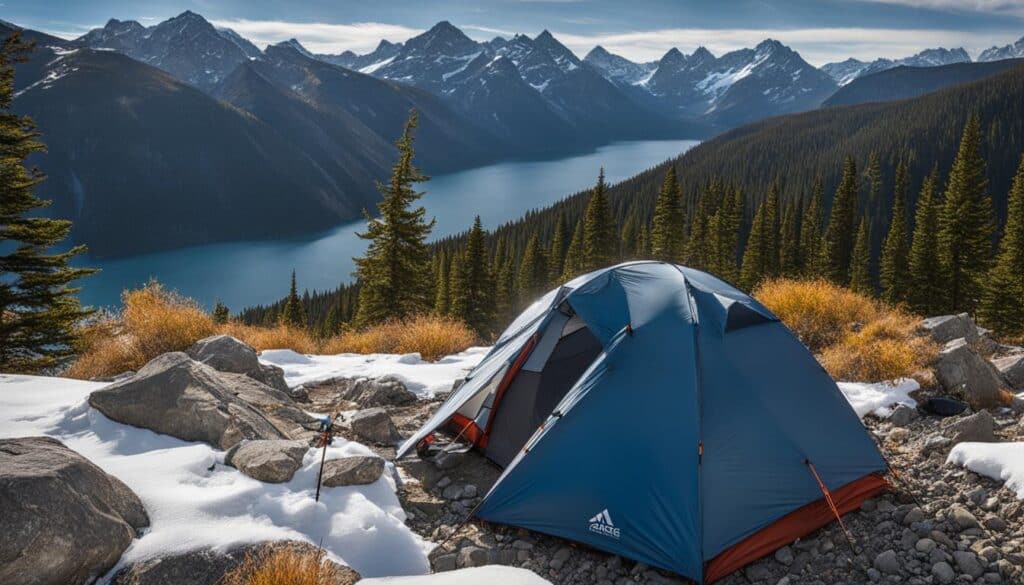
Dealing with Temperature Changes
When camping at high altitudes, it’s important to be prepared for temperature fluctuations, especially during the night. The cold temperatures can make it challenging to stay warm and comfortable throughout your camping trip. Here are some tips to help you deal with temperature changes:
1. Dress in layers
Layering your clothing is essential when camping in extreme temperatures. Start with a moisture-wicking base layer to keep sweat away from your body. Add a insulating layer such as a fleece or down jacket for warmth. Finally, top it off with a waterproof and windproof outer layer to protect you from the elements.
2. Invest in a high altitude sleeping bag
A high altitude sleeping bag is designed to provide insulation and warmth in cold temperatures. Look for a sleeping bag with a temperature rating that suits the climate you’ll be camping in. Consider down-filled sleeping bags, as they provide excellent insulation and are lightweight for easy transport.
3. Use a sleeping pad or insulation underneath your sleeping bag
A sleeping pad or insulation underneath your sleeping bag can provide an extra layer of warmth and insulation from the cold ground. Insulation can help prevent cold air from seeping up into your sleeping bag and keep you more comfortable throughout the night.
By following these tips, you can better prepare yourself for temperature changes during high altitude camping. Keeping warm and comfortable will enhance your overall camping experience and allow you to fully enjoy the beauty of the mountains.

Acclimating to the Altitude
When embarking on a high altitude camping adventure, it is essential to acclimate to the altitude to ensure a safe and enjoyable experience. The thin air and reduced oxygen levels at high altitudes can have a significant impact on your body, so taking the time to adjust is crucial.
One of the best ways to acclimate is to arrive at your camping destination a few days ahead of time and gradually increase your altitude each day. This allows your body to adjust to the lower oxygen levels and helps prevent altitude sickness. While acclimating, it’s important to take it easy and avoid strenuous activities that could put additional strain on your body.
During your acclimation period, it’s also essential to stay hydrated. The dry air at high altitudes can lead to increased water loss through respiration and sweating. Be sure to drink plenty of water and avoid caffeine and alcohol, as they can contribute to dehydration.
Lastly, it’s important to listen to your body and be aware of any symptoms of altitude sickness. Headaches, dizziness, nausea, and shortness of breath are common signs of altitude sickness. If you experience any of these symptoms, it’s crucial to descend to a lower altitude and seek medical attention if necessary.
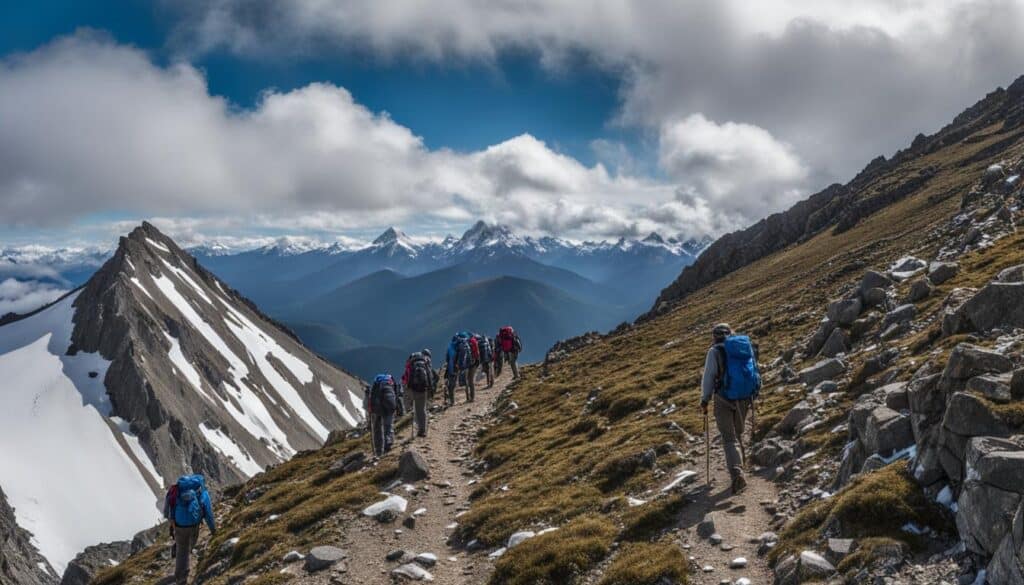
In conclusion, acclimating to the altitude is an essential step in preparing for a high altitude camping trip. By taking the time to adjust to the reduced oxygen levels and paying attention to your body’s signals, you can ensure a safe and enjoyable outdoor adventure.
Safety Considerations
When camping at high altitudes, it’s important to prioritize safety to ensure a successful and enjoyable experience. Here are some key safety considerations to keep in mind:
Altitude Sickness Prevention
- Gradual Ascent: Gradually increase your altitude over a span of days to allow your body to acclimate to the lower oxygen levels. Avoid sudden jumps in altitude.
- Stay Hydrated: Dehydration can worsen the symptoms of altitude sickness. Drink plenty of water throughout your trip to stay hydrated.
- Recognize Symptoms: Familiarize yourself with the symptoms of altitude sickness, which may include headache, dizziness, nausea, and shortness of breath. If you experience severe symptoms, descend to a lower altitude immediately.
- Medication: Consult with a healthcare professional about medications that can help prevent altitude sickness. It may be advisable to carry medications such as acetazolamide (Diamox) as a precaution.
High Altitude Camping Safety Tips
- Weather Preparedness: Be prepared for changing weather conditions at high altitudes. Pack appropriate clothing, including layers, to stay warm and dry.
- Emergency Communication: Carry a reliable means of communication, such as a satellite phone or a personal locator beacon, in case of emergencies.
- Navigation Skills: Familiarize yourself with maps and navigation tools to ensure you can navigate safely in unfamiliar terrains.
- First Aid Kit: Pack a well-stocked first aid kit with essential supplies for treating common camping injuries and illnesses.
- Risk Assessment: Assess the risks associated with your camping activities, such as hiking or climbing, and take appropriate precautions. Avoid unnecessary risks.
By following these safety considerations and being prepared, you can mitigate potential risks and have a safe and enjoyable high altitude camping experience.
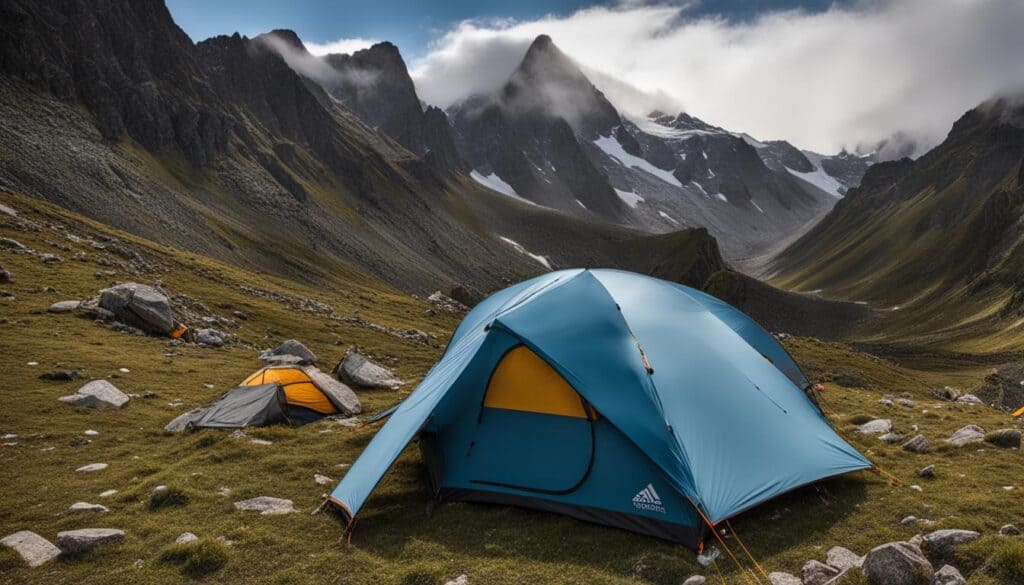
| Altitude Sickness Symptoms | Prevention |
|---|---|
| Headache | Gradual Ascent |
| Dizziness | Stay Hydrated |
| Nausea | Recognize Symptoms |
| Shortness of Breath | Medication |
Conclusion
High altitude camping offers a thrilling and rewarding experience for outdoor enthusiasts like myself. By following essential tips and preparing properly, you can enjoy a safe and enjoyable camping adventure in the mountains.
One of the most important aspects of high altitude camping is acclimating to the altitude. It’s crucial to give your body time to adjust to the thin air and reduced oxygen levels. This can be done by gradually increasing your elevation and allowing yourself enough time to acclimate.
Additionally, dressing appropriately for the extreme temperatures is essential. Investing in a high altitude sleeping bag and layering your clothing can help you stay warm during the cold nights.
Lastly, choosing the right campsite and reinforcing your shelter are key factors in ensuring a successful high altitude camping experience. Look for a campsite that offers protection from strong winds and consider using high altitude tents that are designed to withstand the challenging conditions.
With the right mindset, preparation, and attention to safety, high altitude camping can provide unforgettable memories and experiences. So gear up, embrace the challenges, and immerse yourself in the breathtaking beauty of the mountains during your next high altitude camping adventure.
FAQ
What is high altitude camping?
High altitude camping involves camping at high altitudes where the air is thin and the temperatures are cold. It offers a unique and thrilling experience for outdoor enthusiasts.
What are the challenges of high altitude camping?
High altitude camping presents challenges such as dealing with reduced oxygen levels, extreme weather conditions, and physical exertion.
What are the benefits of high altitude camping?
High altitude camping offers benefits such as breathtaking views, a sense of accomplishment, and the opportunity to experience unique natural environments.
How do I choose the right campsite for high altitude camping?
When choosing a campsite, consider factors such as proximity to water sources, wind protection, and level ground for pitching tents.
How can I reinforce my shelter for high altitude camping?
To reinforce your shelter, use sturdy tent stakes, guy lines, and consider using a four-season tent designed for harsh weather conditions.
How can I stay comfortable in fluctuating temperatures during high altitude camping?
To stay comfortable, dress in layers, use a high-quality sleeping bag suitable for cold temperatures, and bring extra insulation such as a sleeping pad.
How can I acclimate to the altitude during high altitude camping?
To acclimate, gradually ascend to higher altitudes, stay hydrated, and listen to your body for signs of altitude sickness.
How can I ensure safety during high altitude camping?
Prioritize safety by having a first aid kit, researching potential hazards, informing others of your plans, and being prepared for emergencies.

